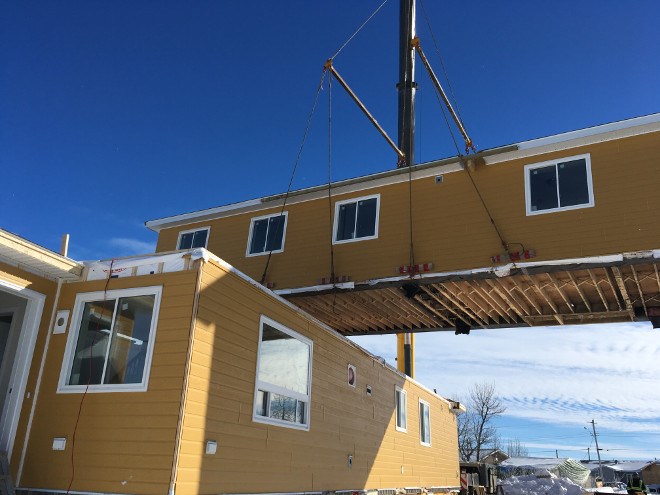March was a milestone month for hundreds of residents of the remote First Nation community of Kashechewan.
It marked the final lift of 52 duplexes (104 units) onto its foundation, thus completing a housing project that began last July in the Far North community of 1,700 on the Albany River.
In May 2014, 36 homes were damaged in Kashechewan were damaged due to flooding from the snow melt. It forced the evacuation of 454 residents to temporary accommodations in Kapuskasing.
Over the past few months, as the new homes in the $47-million federal housing program passed inspection and became ready for habitation, residents who were displaced for as long as three years began trickling back into town.
Tundra Construction, a First Nation-owned company headquartered in Moose Factory, served as a subcontractor under the general contractor, Vytis Lands (Kagawong), a subsidiary of Belanger Construction of Sudbury.
“We did all the foundations, all the training, we stitched the units together and the final buttoning up of the units to get them ready for the handover to the clients,” said Terry Sutherland, president of Tundra Construction.
The duplexes were constructed by Maple Leaf Homes in New Brunswick with the first batch of 32 transported up through Quebec last year, across James Bay by tug and barge, and then up the Albany River to the community.
The remaining 20 were trucked to Cochrane, loaded onto rail for the trip to Moosonee before being offloaded onto truck for shipment on the James Bay winter road.
While creating a new subdivision in Kashechewan was an event of great magnitude, probably the most positive outcome was that almost all the primary labour was local.
“Our workforce was 99 per cent local band members,” said Sutherland, with an estimated 50 residents working alongside experienced tradespeople in roles as carpenters, labourers, electricians, plumbers, lifting and rigging.
The two-storey duplexes arrived in four box-like pieces, ranging from three or six-bedroom units, and weighing as much as 30,000 pounds. With a 120-ton crane, the boxes were hoisted into place using cables and placed on the foundations.
“This whole system (of handling modular homes) was new to pretty much everyone up there,” said Sutherland. “The first one was a learning process for a lot of them, but after that it was just general carpentry with the beams. It was a different process as compared to a stick-built house.”
As of late March, 32 duplexes (64 units) had passed inspection. The other 20, which arrived over winter, will be turned over to families in the coming weeks before the project wraps up in June.
Brad Dobson, Tundra’s CEO and operations manager, said it was very precise work to lift the boxes into place, within quarter-inch margins, before sealing them together.
The skill and work ethic of the residents impressed Dobson, who said, “without a doubt,” he would hire some of the locals for future projects that the company is bidding.
“There are a great group of guys up there, and some females as well,” said Sutherland. “They really performed way better than we could’ve even expected.”
For many participants, it was their first exposure to construction.
Sutherland said about half had some carpentry experience, having worked on building renovation projects.
“The feedback we’ve been getting was that it was a very positive project. It’s been going very well with a good atmosphere.”
After demolishing the flood-damaged and mould-filled homes in July, the speed by which the houses went up starting in early August surprised and pleased residents.
“We started with a barren field and a few months later there are 52 duplexes so it’s a whole neighbourhood for the community. They really noticed and were proud of what they accomplished.”
Phil Sutherland, owner of Cree Consulting and Project Management, who oversaw much of the onsite training for Tundra, called the home lifting project probably one of the biggest construction projects in the area.
Many of the skills the residents gained on this project are transferrable to other infrastructure work and possible careers in the resource sector, he said, if residents are willing to leave the community.
“One younger man, who was doing wiring, first came on as labourer-delivery guy, and he seemed to have the smarts to put things together. He took instruction well and said he would consider becoming an electrician full-time and might go back to school.
“We’re planting those seeds in different people.”
Sutherland said one young lady began work as an outside carpenter, “now she’s one of our better plasterers and painters. She’s doing well, and we feel confident to leave her on her own to do a house.
“We’re happy to hear some of those stories.”
He estimates six or seven women participated, either working in the trades, security positions, or cleaned the units before families moved into the units.
“Out of the 50, there are four or five great lead hands. Those guys have years and years of experience and are able to do multiple things: finishing carpentry, painting, and plastering. There a handful of about 15, who are very skilled at what they do in exterior finishing, and can take direction.
“There are guys that we’d certainly consider bringing with us if we were successful in securing work in other communities.”
In March, Kashechewan signed a framework agreement with Ottawa and Queen's Park to come up with a long-term community plan for better housing and health programs, infrastructure development, and schools. Included in those plans is a possible relocation of the community to a less flood-prone area.




